These are the ramblings of Matthijs Kooijman, concerning the software he hacks on, hobbies he has and occasionally his personal life.
Most content on this site is licensed under the WTFPL, version 2 (details).
Questions? Praise? Blame? Feel free to contact me.
My old blog (pre-2006) is also still available.
See also my Mastodon page.
| Sun | Mon | Tue | Wed | Thu | Fri | Sat |
|---|---|---|---|---|---|---|
| 1 | 2 | 3 | 4 | |||
| 5 | 6 | 7 | 8 | 9 | 10 | 11 |
| 12 | 13 | 14 | 15 | 16 | 17 | 18 |
| 19 | 20 | 21 | 22 | 23 | 24 | 25 |
| 26 | 27 | 28 | 29 | 30 | 31 |
(...), Arduino, AVR, BaRef, Blosxom, Book, Busy, C++, Charity, Debian, Electronics, Examination, Firefox, Flash, Framework, FreeBSD, Gnome, Hardware, Inter-Actief, IRC, JTAG, LARP, Layout, Linux, Madness, Mail, Math, MS-1013, Mutt, Nerd, Notebook, Optimization, Personal, Plugins, Protocol, QEMU, Random, Rant, Repair, S270, Sailing, Samba, Sanquin, Script, Sleep, Software, SSH, Study, Supermicro, Symbols, Tika, Travel, Trivia, USB, Windows, Work, X201, Xanthe, XBee
 &
&
(With plugins: config, extensionless, hide, tagging, Markdown, macros, breadcrumbs, calendar, directorybrowse, entries_index, feedback, flavourdir, include, interpolate_fancy, listplugins, menu, pagetype, preview, seemore, storynum, storytitle, writeback_recent, moreentries)
Valid XHTML 1.0 Strict & CSS
(Disclaimer: This post is about a game. It is all fiction.)
Okay, it's been a while, but I'll try to remember what happened a few days back. I already described today's meeting, so I will skip to the puzzles. Bas, the creator of these puzzles has also written a nice piece on how they were created.
Easy start
To find the device to disable our localization implants, we were given a clue with 10 hexagons on it. These hexagons were marked in some way, possibly representing numbers. Also, there was "MA 5/6 214040" on the clue. MA 5/6 represents college hours, the number is a course number.
Half our team was on their way to pick up their bikes, only Brenda and I managed to take them with us after the chaos just before. So, immediately after the meeting, the two of us went for some WLAN coverage at the Hogekamp building, to look up where the given course was held in the given time slot, since that was undoubtedly the next location.
This gave us "Langezijds 2520". The rest of our team had arrived home by now, so we called in somebody with a photo camera and the exact location of the 2520 room within the (huge) Langezijds building. I sent Brenda home, since we still had all the licenses of our team, so they couldn't really go out. I myself went to the Langezijds building, where I would meet Jasper (a non-contestant) to bring me the camera.
We had seen some delay at Hogekamp, due to 2d4d trying to kill us (first time within the 10 minute safe time, second time they had come back for the kill. ah well, the puzzle is more important than killing anyhow and I managed to return the favor of a kill). But, due to this delay, we arrived second, after team CIA (nicely done, CIA). There, I could not find the clue at once, but did find it shortly after. Hoping that CIA would go away so I could write down the clue, I delayed a little. In the end, another team arrived, so I had to be more careful. Also, Jasper arrived with my camera. As soon as the third team arrived I decided to screw it and give the clue away to team CIA. I climbed into the fire ladder to make a proper photo of the clue. In the end, it turned out to be a good decision, since on our way back, we met at least 4 teams coming our way behind the Langezijds building...
The clue had a few aspects to it. First, there was "MISSING LINKS". Second, there were three lines, each sharing a single starting point, pointing upwards, bottom left and bottom right. There were markings "T", "L", "R" in the top, left and right parts of the figure respectively. Lastly, there was
GOTO(SUM(L,R)
REMEMBER(T)
by now, we had pretty much established that the markings on the original clue were numbers, encoded with the bars meaning 5 and the dots meaning one (This turned out tot be Mayan counting in the end, but we didn't know that). If we overlaid the TLR figure over each hexagon on this clue, we could label each number with T, L or R.
Easy puzzle taking too much time...
We thought that perhaps we should take a path through these hexagons, remembering the T at each step, so the T's would form a message somehow. The path would be defined by the GOTO statement. But for a few variations of starting point and interpretation of the GOTO statement, this didn't seem to work out. It did give us a few possible numbers, so nearly guessing we searched a few buildings, to no success.
We decided to buy the hint, so (after we bought the wrong hint at first, they shouldn't put two clues on one paper ;-p), which read "Six ribs plus three is a die". So, we had to make a cube out of the figures we got, apparently. So, Frank and I had been checking the cubicus building (even before the hint...) and returned home now. When we got there, the rest had found that putting the lines into each hexagon, gave a drawing of a cube. Obviously. Yet, this hint did nothing to help us, since we already established which numbers were T, L or R.
In the end I tried taking the sums of L and R on each hexagon and translating them using simple A=1 translation (so B=2, C=3, etc). I had already suggested this quite some time before, just when I was about to leave to check a building. Apparently people had not understood what I meant then, since I turned out to be correct. Doing this gave us "gebouwnrbj", which seemed promising, but what is "nrbj"? Quickly we realized that it should be "nr29", leaving the last two numbers untranslated, which is the Pinetum.
Sudoku madness
 Speeding there, we found the next clue: A big sudoku (with the text
"Sudoku 3x4" at the top and the right) with a huge "Plus" sign next to it.
While normal sudoku's are always 9x9, with 3x3 subareas and numbers from 1 to
9, this sudoku was 12x12, probably had 3x4 subareas and included a 0, a - and
a +, for a total of 12 different numbers (which matches the line and subarea
size).
Speeding there, we found the next clue: A big sudoku (with the text
"Sudoku 3x4" at the top and the right) with a huge "Plus" sign next to it.
While normal sudoku's are always 9x9, with 3x3 subareas and numbers from 1 to
9, this sudoku was 12x12, probably had 3x4 subareas and included a 0, a - and
a +, for a total of 12 different numbers (which matches the line and subarea
size).
Since we didn't know whether 3x4 meant three down, four across, or the other way around and the 3x4 was listed in two directions, we assumed either there would be one solution, no matter how you would interpret the direction, or there would be two solutions which could be overlapped somehow (Taking only differing squares, for example).
C++ hacking
So, we went to the Langezijds building to upload the picture we just took, so
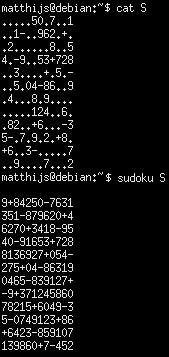 the people at home could started puzzling. Jeroen and Frank went back to the
clue, since it contained a flash hiding a few squares. While they were away, I
decided to hack the (C++) sudoku/kakuro solver we used the day before to solve
these different sudoku's. We continued this hacking inside the Zilverling
building, so we would be in the field already for the next clue. My original
estimate of 15 minutes of coding turned out to be rather good, within 30
minutes I had a correct solver for either 3x4 or 4x3 sudoku's. I did not
realize that yet, then, since the solver kept returning multiple results on
each sudoku. After some extended code review and sudoku checking, it seemed
there was no error in my program. Time to return home and blame the
organization for giving us ambiguous sudoku's.
the people at home could started puzzling. Jeroen and Frank went back to the
clue, since it contained a flash hiding a few squares. While they were away, I
decided to hack the (C++) sudoku/kakuro solver we used the day before to solve
these different sudoku's. We continued this hacking inside the Zilverling
building, so we would be in the field already for the next clue. My original
estimate of 15 minutes of coding turned out to be rather good, within 30
minutes I had a correct solver for either 3x4 or 4x3 sudoku's. I did not
realize that yet, then, since the solver kept returning multiple results on
each sudoku. After some extended code review and sudoku checking, it seemed
there was no error in my program. Time to return home and blame the
organization for giving us ambiguous sudoku's.
Arriving home, this turned out to be unnecessary. Somebody realized that instead of solving two different sudoku's, we should solve one sudoku with both the constraints (so, containing both the types of subareas). I hacked the solver again to support this, which was less effort than finding a way to make an intersection of the ambiguous results for the two different variants. Applying my modified solver (BSD licensed) to the given sudoku gave us a 12x12 matrix full of numbers, pluses and minuses.
The big plus

This is were the big plus to the right came in. We had assumed so far that it would help us interpreting the result of the sudoku. Since there were plusses and minuses in the matrix, it would make sense to see it as a huge calculation, reading left-to-right, top-to-bottom. This resulted in some huge number. This is were the plus came in. If we would sum the digits of this number, we would get 54. If we would do this again, we would get 9, the building number of Citadel. Finding nothing there, we tried a bunch of other variants, such as reading the numbers top-to-bottom, right-to-left and taking the difference or sum of these both, etc. This only gave us more trips into the cold, without success. After returning to the Pinetum to take exact measure of the sudoku and the plus (to see if we couldn't overlay it somehow), we decided to go for a long shot: The cross might be a medical cross, and totally unrelated to the sudoku. (I wonder if any team actually saw this at first?)
Light it all up
Right, so the next clue was again a puzzle ("Light it all up") with next to it a small "treasure map", with a soccer ball, a "Mondriaan" painting and a butterfly, referring to those respective locations. There was also a cross which, when overlaid on the campus map with the given locations aligned, ended up somewhere (Don't know exactly where, the field team solved this on the spot). On this last location we found an extremely weird figure: three matrices on the left, with lines to squares on the right. Since two squares had already got symbols like the first clue filled in and there was "REMEMBER?" at the top, this clue obviously should be combined with the first one.
Also, the puzzle found at the medical center, (the "lights puzzle"), was a 10x10 grid with a gray border, one tile wide, around it. Also, it was bordered with the same dotted line as the sudoku ("So that is what that dotted line meant!"), so the light puzzle would obviously give an overlay to the sudoku, when solved.
Now what...
Next up was hours and hours of puzzling and staring blankly. Especially for the lights puzzle, we spent a lot of time finding ambiguous solutions using the wrong rules. In the end, Jeroen had found the rules to the the "light up" puzzle game, which this puzzle turned out to be. Using these correct rules, solving the puzzle was quickly done. Overlaying it over the sudoku, the squares with lights on them returned "90-365-2349-4". Googling for this number did not help, nor did searching for it on book selling sites (amazon, bol) or ISBN databases (since it rather looked like an ISBN number).
In the meanwhile, we had been staring at the other puzzle a lot too. There were ten empty squares to the right, and we had remembered ten different figures (or numbers) at the first clue. But, how to find which one belonged where? Trying to find a connection between the numbers to the left didn't really work out, but putting the figures to the right in such a way that no adjacent figure had the same number of bars or dots, gave us an unambiguous solution. Still, this did completely nothing with the matrices to the left and didn't seem to produce anything useful...
A different view
After some more blank staring, Frank looked at the figure, and noticed a similarity in numbers. The bottom figure to the left contained nearly the same numbers as the top numbers we remembered. I had spotted this before, but since it didn't match perfectly I dropped that thought. but, what I did not see and Frank did, was that not only the numbers would match the cubic figure, also the positions matched. If you would look at the cubic figure from above, you would get the bottom matrix (with a few errors). The same went for the two side views, left and right.
So, using these views, we were able to find numbers for every square to the right. If we turned the two middle cubes counter clockwise, we would even make the views correct again. (It turned out that turning the cubes themselves wasn't the original solution, but turning the missing links we put in was. This way, you would change the cube in such a way that instead of looking at the exterior of the cube's front, you would look at the interior of the cube's back. This way, the different views would also change in such a way that they are now correct. Anyway, just rotating the cubes works just as well).
Periodic nonsense
So, now we had numbers in all the squares. This is where the last clue came around, which I forgot to mention above. Underneath the squares to the right was "Dmitri Ivanovich Mendeleev", in Russian letters. This guy invented the periodic table, so that would be an easy way to translate numbers into letters. The thing was, if we did that, we would find "He" in both the top squares, "BAlBLiOMgK" in the center and "AlSBN" at the bottom. Together with the near ISBN number, this should have been quite obvious. Except for a few letters, this spells Bibliotek and ISBN. But, being as exhausted as we were, we didn't see this. Also, a clue is not a clue if it isn't a perfect fit, it's probably coincidence anyway (like you get "mpeg" from the bottom characters if you use A=1 translation...). Lastly, the squares to the right weren't ordered in such a weird way for nothing, that had to mean something too.
#mep UB searching system
Still, since it looked like an ISBN number, I decided to check it again at the university library. So, filling in the number in their search machine, I wanted to click search. Just before that, I looked at the drop down box, which presented a choice between "Title", "Author", "ISBN number", etc. Since the default choice was "all words", which I assumed to mean "all fields", since the other options were fields in which to search, I left it at that. No results. If only I had selected ISBN there and then, or the UB didn't have such a crappy system (more on that later) we would not have had to freak out the organization (sorry fizz ;-).
Instead, we had told our methods and conclusions tot Joost (V), who was filming this week. Though he was not official organization, he had been told the solution to this puzzle and hinted us we were going in the right direction. But, when he didn't manage to get a correct result from the puzzle, even when knowing the puzzle, he contacted the organization (which were pretty much available up till then), claiming he thought the puzzle was incorrect. After some phone calls it was established that we just missed a small detail to make stuff correct.
Fortunately, somebody else (Marijn IIRC) tried the UB search again and found the title "Electronic schematics for world domination" (Note the references to past Pandora's. McPhisto was the 2003 main character, Panta Corp was the 2005 theme, Osato was last year's winning(?) team, now fully retired).
#mep UB indexing system
Obviously, this was the way to go. So, we went off for the library, which is temporarily in the Langezijds building (yes, were the very first hint was, too). When we got there, we had obviously forgotten to note down the shelf number, so we got outside again to look it up on my laptop. Next up was the biggest puzzle of the day: Where the hell is "CBa 37 s018"? After some walking around we asked the librarian, who told us it was downstairs. "Hey, there is a downstairs!"
So looking further we discovered the 37 department. Looking there, we didn't find it. Marijn went off to ask organization if there was an actual hard copy there, when Bas (fizzgig) walked in, being just as puzzled as us that it wasn't there. He asked another library employee, who had helped him arranging the entire thing. She walked there without hesitation, pointing out the correct title. Apparently, books labeled
37 .0019 s021
are not department 37, but 37.0019. Argh. They need a UB for dummies printed very big on some wall...
The victory dance
Anyway, we got the frigging book! It just turned out that the schematics for the most critical part was accidentally erased by a big coffee stain... Brilliant. Oh well, we were done for the day. It also turned we were the first one to solve the puzzle, even though someone from the Happy Hooves had claimed they already did so around 0700... Time to go home and drink some tea with Bas, the inventor of all these puzzles and Joost (K), our cameraman and supporter during the night (though we would probably have been better off getting some sleep...).
This was the moment Bas told us how we should have gotten Bibliotec ISBN from the square thingies. It turns out that the bars and dots was the way Mayans used to count. Using 0-3 bars and 0-4 dots (and originally a special character for the 0, which we did not need) you can make 0-19. If you stack multiple of these numbers, you will simply get a number in base 20. So, where we got "He" stacked on top "Al" (2 on top of 13) we should have gotten "i" (2 * 20 + 13 == 53 == Iodium). This also fixed ISBN. In the same way, the "Mg" in our word should have been "Te" (Tellurium IIRC).
Auspex 10: Hindsight
When looking back at these puzzles, they weren't actually that hard. I mean, if only we had just googled for dots bars numbers, we would have found the Mayan counting. If we had only clicked the correct drop down in the UB searching system, if we had only tried the correct translation when we first thought of it instead of an hour or two later... I am not sure what exactly the difficulty in these puzzles was, but it seems we have been pretty much screwing up a lot too... Ah well, easy talking after-wards...
Coming up next???
Anyway, I've spent my entire trip from Enschede to Ermelo typing this, plus another hour in Ermelo. Add to that another hour or two finding all the pretty pictures to go with it... Goddamn hard & long puzzles ;-) I'll see if I'll get to writing a piece about the last day, is anyone still interested in this? If so, do comment!

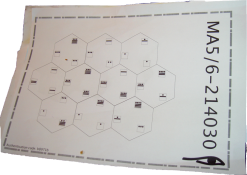
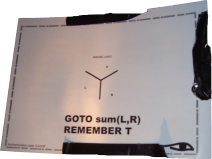


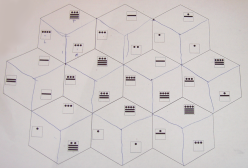
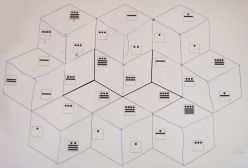

There were a few shortcuts indeed (the ISBN number for example), but overall it was no simple task analysing all these (for a Pandora evening, 4 puzzles is a lot) and solving them. I had quite a laugh creating them and enjoyed your enthousiasm in solving them. Nicely done! (but I claim victory in the Mendelev puzzle :P)
Yes, interested!!! More, more, more! We need to keep this in archive for our offspring. Or something. :p And if you wouldn't blog, my linking to you wouldn't make sense. :-p
The difficulty was not solving the puzzle, it was interpreting the answer. If your puzzle spits out 90-365-2349-4, you seriously begin to question the validity of your answer. Filling in the Mendelev puzzle again produced a result that seemed wrong at first sight, so you try another approch. Puzzles that require two steps before any confirmation are extremely hard.
Comments are closed for this story.